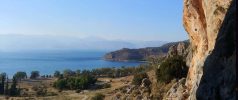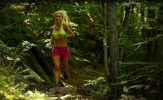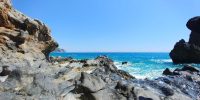N 40°05'03.7"
E 22°24'24.5"
Out of many Greek inventions, sport probably made the biggest career. Almost nobody practices philosophy anymore, almost nobody values science, but sport is on top. Of course, this and that have changed since the first Olympic Games, but the main principles have remained the same: noble competition, „swifter, higher, stronger”, cross your own limits.
Peloponnese

READ MORE
This last slogan probably best characterizes amateur sport, and already perfectly suits mass runs held in the mountains. Not only though. It seems that the entire contemporary culture is geared to crossing borders in various areas. In any case, many people like to describe their activity in this way. And it is hardly surprising since so much emotion is caused by such a prosaic activity as running. I also say this from personal experience. Every time I stand at the start of the competition I ask myself: what makes all these people make such a huge effort? What makes me follow them? I am talking now about ultra runs that are 100, 170 or even more kilometers long and last 24 hours or even several days.
most difficult race
So if to cross own limits, why not on Olympus, the highest mountain in Greece, which by definition is the border, between the world of gods and people of course. And best in July, when the chances of really extreme temperatures are greatest. There are at least 10 different competitions organize in the whole massif of the mountain of gods, I competed in several myself, but the 2017 Olympus Mythical Trail was a border-line experience, not comparable with anything else, neither before nor after.
Olympus Mythical Trail is considered the most difficult mountain race in Greece.* Of course, this cannot be measured with precision, but when during other competitions I mention that I was running OMT 100 I see a flash in eyes and I hear words of admiration. The route leads around the entire massif, partly along old, forgotten paths, brought back to life by the organizers. There are no villages or permanent human settlements along the way. The impression that you are on the edge of the inhabited world, and even beyond it, is very strong. In any other race I didn’t have so intensive feeling – only me and the Mountain.
Lost Trail

READ MORE
two different loops
The race starts on Friday at 17.00 from Agios Ioannis, a small clearing among forests, 4 km from Litochoro. It is very warm, forecasts for that day promise 42 degrees C in the shade, but I want to believe that at an altitude of 600 m will be a bit cooler. This beginning is beautiful. A high mixed forest that gives shade, a narrow but comfortable and wonderfully laid path. I am here for the second time, and I still can’t get over how diverse this forest can be. Trees everywhere, but many more species than in Poland. Every now and then the undergrowth is changing, once it is dense and full of bushes, again intensely green grass dominate. And everywhere a lot more colors, everything blooms as if it was the beginning of spring, not the high summer. Sometimes, in the open air, there are more sounds: cicadas and various other insects are playing. Litochoro can be seen somewhere below, the clear shape of the coastline besides, the blue of the sea and the Halkidiki peninsula on the other side of the bay.
The OMT 100 route is clearly divided into two sections. The first – “small loop” is 32 km and leads from Agios Ioanis to Litochoro. It runs quite gently up to 2000 meters above sea level to later run to 300. The second, large loop is actually one great uphill to the main dome of Olympus and an equally great downhill. In detail, the route is much more diverse, and the downhills and ascents are intertwined much more often.
We are running higher, it is getting later, but I do not feel that’s getting colder, like previous year. Livadaki hut at a height of 2,000 m. On downhill the path is equally narrow and beautiful, but the way down doubles the pleasure. I accelerate, carried by the euphoria of the beginning, and deep down I explain to myself that I should run as many kilometers as possible in the light of day. In Enipeas Gorge gets warmer: stuffy, stagnant air, so thick that it can almost be cut with a knife. I don’t slow down, however, I run past known places: Agios Dionizios Monastery – an oasis of peace and quiet in the middle of the mountains and a hermit’s shrine in a rock with steep stairs. I run out of the ravine to return to it in a moment, in complete darkness, right next to the small pond Lambada. From here it is less than a kilometer to the food point in Litochoro. This first episode I should run in about 5h 30 min, last year it took me 5:12, now I’m under 5 hours. Too fast, of course, but who said madness is rational.
The person responsible for all of this is Lazaros Rigos (on the left) – a man whose contribution to the development of mountain running in Greece is hard to overestimate. One of the originators of the first competition held here in 1986, organizer or consultant of almost all the most important competitions on the Aegean Sea, mountain runners community animator, one of the co-founders of HARTA – the Hellenic Adventure Running &Trail Association* – a man-institution. An active and very good runner.
At the nutrition point, it turns out I’m 8th! The call “Keep it up” I treat as an impossible spell, as reality can be deceived, but usually for a short time. I’m slowing down. Objectively very clearly, because there is a steep approach, but also proportionally, because I am overtaken by several runners. I save my strength for the rest, because the real run is just beginning. Again, I realize one of the basic features of ultra races – loneliness. At the forefront, the breaks between competitors are relatively large and I run alone to the very end. Even if someone overtakes me, he does it very quickly and soon disappears from my sight.
run in the night
It’s night. I do not mind. It is good that it is night on this great 5-hour climb, when you overcome some 2,500 meters of elevation. The night brings great peace and quiet, although I am not sleepy at all. The moon is shining, but through the dense foliage of the trees I don’t get much of this shine. I even darken the headlamps, not to disturb this night’s peace. I run slowly so minimal light is enough for me. There is monotony and a slight exhaustion, but I try to celebrate them, they are such an important part of ultra run. Changes will inevitably come and I know that I am getting closer and closer to them with every step.
sky begins to shine
In Mediterranean countries, the night is longer than in the north. At 5 a.m. it is still completely dark, but uphill is finishing. Some time ago the forest ended. I run to the Muses Plateau and the sky begins to shine. Almost everything is still black and dark blue and densely set with stars, but in the east there is already a clearly brighter, reddish glow and the world comes alive. You can see the outlines of the peaks around and although the space still has only two dimensions, I have no doubt where I am. The plateau itself also starts to light up, or rather the Apostolidis Refuge which is located on the right and the headlights of other competitors who are approaching it. I know that the sun will rise soon and time will accelerate. At Olympus we are lucky that the downhill begins exactly with the sunrise. And the light is important, because the narrow path Zonaria, slightly descending and traverse the peaks of Stefani and Mytikas, encourages more madness. Right next to it is a cliff or very steep scree, so a bit of prudence is also useful.
I run in ecstasy. The new day gives the runner new strength, almost does not feel that it is the 60th kilometer. At least until the next ascent. The large, sloping wall of Skolio, with 500-meter elevation and loose stones escaping from under the feet. This time I deal with it much better than last year, although I still remember it as the most difficult part of the whole route. I still run alone, sometimes stop and take pictures but without much faith that the uniqueness of the moment can be preserved.
After Skolio, the meadows of Olympus begin, the grassy fields covering all the peaks in the area of Agios Antonios, the highest place where the ancients sacrificed to Zeus. Easy ascent and much more difficult descent. The path almost does not exist, there are only clumps of grass, fragile, moving stones and a tiny shelter, visible somewhere … far, far below. There is also no path for the next few kilometers of almost flat section, which is why the route markers painted on stones visible everywhere looks somewhat absurd. I am undoubtedly in a wild corner of the mountains, but gentle shapes and fresh shades of green grass at an altitude of over 2,600 m give a little heavenly impression.
Somewhere in this region I am overwhelmed by this strange feeling sometimes referred to as “runner's high”. As if I was running completely effortlessly and had the impression that I could do it forever...
Crete

READ MORE
celebrating the heat
The world of gentleness ends quite abruptly and decisively. Behind the pass between the Kakavrakas and Metamorfosi peaks everything changes. A huge wall, with the largest downhill on the route, with bends stretching almost indefinitely. Right to the south. It’s a few minutes past 9.00 but in a moment it gets really warm. The biggest hero of this competition enters the stage – the heat! It’s just hot at the downhill, but I’m getting the impression as if the African mass of air that was supposed to be here the day before was a bit late and arriving right now. The downhill takes the last of strength, and then there are two almost flat sections separated by an aid station, together no more than 24 km. The route leads through meadows and wide forest roads, near which trees grow rarely and give no shade at all. I do not know what is the objective temperature, but it seems to me that I have never felt so hot air on me. And I don’t even want to drink much, I start saving water to pour it on my head.
I feel the greatest need to cool a hot body. It helps only for a moment, but it works. I’m not suffering, I don’t fall faint, it doesn’t dry in my throat, I move quite well. The unique heat from heaven does not frighten me. I just miss water more and more radically. I’m starting to understand what water is in Greece. Not some big rain or sea, but those little springs and streams that flow here and there, and I am not surprised that they are considered sacred.
I run into a food point, right on the road, in the middle of the forest. In front of it the stream flows out of the rock and a channel for watering animals and people. There is plenty of water. I enter almost whole, I pour my head and I’m in the seventh heaven.
Phaistos Disk

READ MORE
I’m starting to celebrate the heat. I am getting closer and closer to the finish line, I am getting more and more tired and on the one hand I want to be in place, but on the other I do not want something so special to end.
competition like no other
Out of 174 people who started, only 86 reached the finish line (in the extended time limit by one hour due to the heat). This is the smallest percentage of finishers in the entire history of the race.
However, I would like to reassure running readers who would like to take part in these or other competitions in Greece: out of my 20 starts on the Aegean Sea, it has never and nowhere been so hot as during OMT 2017.
The following report concerns the competition from 2017. It is worth mentioning that starting from 2019, the start has been moved to Litochoro. The route is basically the same, the starting time has changed (from 5.00 p.m. to midnight) and the order of the loops has changed, now a large loop with the highest peaks is at the beginning, and a smaller 32-kilometer loop with Livadaki at the end. For me, this is definitely a more difficult configuration.
MORE POSTS ABOUT OLYMPUS
Lost Trail
My 55 Peaks
Goumarostali Vertical Mile
From Prionia to Muses Plateau






